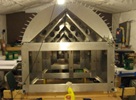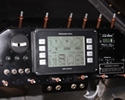


random user submitted photo
Gland nut question
7 posts
• Page 1 of 1
Gland nut question
According to Tom Wilsons book on VW engines he says to torque the gland nut to 300 foot lbs. The Aerovee manual says 227 foot lbs. What have you guys done. I think I would go with the 300 foot lbs. Thoughts?
John
John
- Johns
- Posts: 146
- Joined: Sun Jul 14, 2013 4:32 pm
Re: Gland nut question
I didn't build an Aerovee, but why would you deviate from the factory recommended settings?
John Gillis
SEL Private, Comm Glider, Tow pilot (Pawnee Driver)
Waiex N116YX, Jabiru 3300, Tail dragger,
First flight, 3/16/2013. 403 hours and climbing.
Home: CO15. KOSH x 5
Flying a B-Model Conversion (Super Bee Baby!)
-

fastj22 - Posts: 1594
- Joined: Sun Aug 21, 2011 5:56 pm
- Location: Mile High
Re: Gland nut question
I followed the Aerovee manual.
Bryan Cotton
Poplar Grove, IL C77
Waiex 191 N191YX
Taildragger, Aerovee, acro ailerons
dual sticks with sport trainer controls
Prebuilt spars and machined angle kit
Year 2 flying and approaching 200 hours December 23
Poplar Grove, IL C77
Waiex 191 N191YX
Taildragger, Aerovee, acro ailerons
dual sticks with sport trainer controls
Prebuilt spars and machined angle kit
Year 2 flying and approaching 200 hours December 23
-

Bryan Cotton - Posts: 5226
- Joined: Mon Jul 01, 2013 9:54 pm
- Location: C77
Re: Gland nut question
I followed the plans and set it at 227 ft# . You can borrow a torque wrench For O' Reilly auto parts that goes up to 250#.
Bill Larson
N861SX
Sonex, polished, tail wheel, Generation 4 Jabiru 3300
N861SX
Sonex, polished, tail wheel, Generation 4 Jabiru 3300
- wlarson861
- Posts: 497
- Joined: Wed Dec 05, 2012 11:41 pm
Re: Gland nut question
Even if you have a 250' torque wrench, you still have to exert 250 lbs pressure on the end of it. Even with my heft, that would be lifting myself off the ground to apply the full value to the wrench.
What we did with our AeroVee was to obtain a 3' length of pipe from the aviation dept of Lowes, slide it over a breaker bar (doesn't matter what length as long as the 3' STARTS at the point of rotation - the nut), then suspend 75 lbs of weights (lifting weights) from the other end. 3 x 75 lbs = 225 lbs applied. Gave it a nudge just to bump it up a bit.
I was quite surprised at the results. With me cranking on a breaker bar by myself, I thought it was snug. We then applied the above method to the nut, and we actually had to remove the socket and reposition because the weights pulled the bar down so low.
What we did with our AeroVee was to obtain a 3' length of pipe from the aviation dept of Lowes, slide it over a breaker bar (doesn't matter what length as long as the 3' STARTS at the point of rotation - the nut), then suspend 75 lbs of weights (lifting weights) from the other end. 3 x 75 lbs = 225 lbs applied. Gave it a nudge just to bump it up a bit.
I was quite surprised at the results. With me cranking on a breaker bar by myself, I thought it was snug. We then applied the above method to the nut, and we actually had to remove the socket and reposition because the weights pulled the bar down so low.
- corton
- Posts: 43
- Joined: Fri May 03, 2013 11:00 am
Re: Gland nut question
Remember that the Aerovee uses a custom crankshaft. So you have two reasons to use the torque value specified in the Aerovee manual:
1) It’s the manual, and has been specifically developed and tested by people who operate the engine as well as selling the kit.
2) The higher torque spec you quoted is for a different part. It’s not what you’re assembling when you put together an Aerovee.
Remember that the Aerovee is *based* on the VW, but it’s not actually a VW - so although many VW methods and standards apply, the Aerovee Manual should always take precedence.
—Noel
1) It’s the manual, and has been specifically developed and tested by people who operate the engine as well as selling the kit.
2) The higher torque spec you quoted is for a different part. It’s not what you’re assembling when you put together an Aerovee.
Remember that the Aerovee is *based* on the VW, but it’s not actually a VW - so although many VW methods and standards apply, the Aerovee Manual should always take precedence.
—Noel
- NWade
- Posts: 527
- Joined: Mon Aug 08, 2011 3:58 pm
Re: Gland nut question
Also remember that, in its original application, when the driver dumps the clutch it is those 8 dowels and the gland nut that transmits all that torque. In our application, the only torque on the flywheel is the starter, and the engine never changes rpm rapidly like a car engine does. I'd be surprised if our flywheel needed a fraction of the torque the car ones do.
- lutorm
- Posts: 259
- Joined: Mon May 15, 2017 1:35 pm
- Location: The Island of Hawai
7 posts
• Page 1 of 1
Who is online
Users browsing this forum: No registered users and 11 guests







